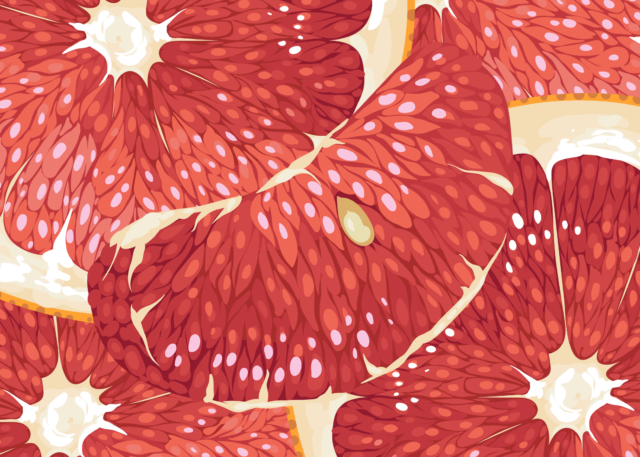
I have never liked grapefruit. They are hard to peel. A friend of mine once used them to practice tattooing: the leathery skin can stand up to the action of the gun, it turns out, plus it holds ink well enough and provides a sizable canvas. I suppose any fruit that can mimic human skin has the right to resist my fingers as they try to reach its flesh. A large knife would do the trick, but I don’t believe fruit should require butchery. I am an American born in the nineteen-eighties; I was raised in a place and time that had subordinated all other values to blithe consumption. I expect any fruit to denude itself in my hands at the slightest effort, like an eager lover or an EZ-peel clementine.
But when I break the skin of a grapefruit, the pith launches its smell at me. In an instant I am drunk on it. At once fresh and dank, it makes me promises; woody, delicate, and nearly fungal, it hints at sharper, sweeter things to come. I wrest the fruit apart to catch the scent of the flesh itself: bracing and soothing, astringent and floral. The interior is the color of a coral reef, or a sun-bleached terracotta floor, or the pink cough drops my mother gave me when I was a child and which I craved even when I was not sick, or raw chicken, or a tongue, or quince paste sliced very thin and eaten with white cheese, from a clean plate, in a sunny garden. I have had grapefruit before. I should know what the inside will look like, since red and pink varietals have thoroughly displaced the white- or yellow-fleshed ones in most supermarkets. But when the fruit is open, I receive its color with delight, as if it were an unexpected gift.
The first bite is like nothing. I was wary of the sharp taste, but what a relief, it’s like water. Then a faint honeyed flavor arrives and everything is better than expected, until a sour note cuts in. My mouth twitches towards puckering even as I want more of that sugared edge. The bitterness lasts longest. At the back of my tongue, nearly down my throat, it makes itself at home.
I think I would rather eat a lemon: bright, sunny, and unabashedly tart. A lemon announces straightaway what it will do to you. Still, each time I glance over the heaps of fresh fruit in the produce aisle, I want grapefruit.
Since the writing of Genesis, if not before, fruit has stood for sex. Beyond Eve’s apple, there are endless references in art and literature, from the pomegranate in Dante Gabriel Rossetti’s Proserpine and the post-coital slice of watermelon Gurov callously eats in Chekhov’s “The Lady with the Dog” to the cherry stem Audrey Horne (Sherilynn Fenn) ties with her tongue in Twin Peaks. Botanically speaking, a fruit is the ripened ovary of a plant. There is also an experiential logic to the sex metaphor. Something hangs out of reach (an apple) or hides coyly amid leaves (a blackberry); it swells as it ripens until it can wait no longer; it is plucked and eaten, giving pleasure and satisfaction. But these soon fade. A new hunger comes, or the old hunger returns. (Who can tell them apart?)
The grapefruit is different. Its pleasures are half-hearted, awkward, incomplete. “I always think that people who say they like it are faking it,” a friend tells me, referring to grapefruit and nothing else.
The grapefruit is a troubled love child. As the story goes, in the seventeenth century, English colonists in Barbados acquired pummelo seeds and began to cultivate them. They did not know that the pummelo, Citrus grandis or Citrus maxima, is near impossible to propagate from seed. It cannot be fertilized by its own pollen. The colonists, however, believed their project was succeeding, since they were producing large citrus fruits — pummelos, as far as they knew. But the pollen of the sweet orange, C. sinensis, was floating in the tropical air. All along, it had been visiting the pummelo plants. This horticultural assignation produced a new hybrid.
Some say the name grapefruit arose because the fruit grows in clusters. John Lunan, a seventeenth century magistrate in Jamaica, wrote that the fruit was so called “on account of its resemblance in flavor to the grape,” referring to the sour sea grape, which grew on local beaches. To add to the confusion, the novel crossbreed was often mistaken for the Forbidden Fruit, another large citrus, now extinct. Hence the grapefruit’s botanical name, evoking the pleasures of a lost Eden: Citrus paradisi.
For years I thought of grapefruit as a food for older people. My great-grandfather reportedly started each day by drinking a raw egg cracked into a glass of grapefruit juice. In more formal households, grapefruit halves were carefully prepared: a cook or housewife would slide a sharp knife along the inner walls of the triangular cells, severing the flesh so it could be scooped out. You can still find grapefruit served this way at chic brunches, but the preparation carries a hint of nostalgia.
These days, however, I notice Citrus paradisi in contexts I associate with people my own age. In 2015, when American millennials became obsessed with LaCroix, the staff of Time Out New York ranked grapefruit first among the flavors. Before the pandemic, I would find grapefruit in dimly lit cocktail bars, where it featured not only in classics like the Paloma or the Greyhound but in new concoctions with names like Upper Cut or Shifting Sands. In restaurants, the tart fruit figures in salads and desserts as a bitter, refreshing accent. Since it opened in 2011, the New York restaurant Boulud Sud has served its legendary grapefruit givré, a hollowed and frozen grapefruit shell filled with grapefruit sorbet and segments, citrus marmalade, and rose loukoum, all topped with sesame foam and halvah candy floss. The website Restaurant Hospitality informs us that red grapefruit’s prevalence on menus is on the rise, growing by 57 percent between 2016 and 2020. According to the Brisan Group, a food and beverage industry consultancy, a trend for the color coral in the early twenty-tens led images of grapefruit to become popular on Instagram, driving the popularity of the fruit itself. Grapefruit is millennial, like my generation’s namesake pink.
Perhaps our growing appreciation for the bitter fruit is evidence of a predilection for irony and snark; grapefruit offers an edgy sweetness palatable to those who spent their formative years reading Gawker and Vice. We who came of age under the sign of the hipster want you to know that we appreciate complex tastes. Some protest that they hate grapefruit, but then they give it lots of attention. An article in Slate titled “Grapefruit Is Disgusting” details the fruit’s off-putting qualities, and Bon Appetit advises us on “How to Have Grapefruit for Breakfast Without Crying.” Maybe we millennials like grapefruit because we don’t.
Or grapefruit’s appeal might lie in the experience of a generation raised in an environment of extreme competition. We need to prove our worth in every way possible. Grapefruit suggests the Puritan notion of a chosen elite destined to attain salvation, or, in neoliberal terms, success. After all, the sharp flavor is not for the faint of heart or palate. The grapefruit-eater can take complex pleasure in immediate pleasure’s absence. He is both a stoic and a sophisticate. He knows that a stitch in time saves nine and a penny saved is a penny earned, particularly if you don’t pay taxes. Even a progressive might be susceptible to this Reaganite of the fruit kingdom.
Grapefruit proposes a convolution of consumption; it inverts indulgence. One of the first fad diets, still popular today, involves eating one half of a grapefruit before each meal on the theory that the fruit contains special fat-burning enzymes. Many contemporary dieters believe that you burn more calories chewing and digesting grapefruit than you take in by eating it. Indulgence is abstinence. If you get your kicks from getting no kicks, it is all kicks all the time, and no kicks all the time, at once. You reach an apotheosis: no guilt, no shame. If you eat the flesh that unmakes flesh, are you even eating?
The grapefruit, in which asceticism meets debauchery, might also speak to a cohort said to have problems with sex. Kate Julian’s controversial 2018 Atlantic cover story broached the idea of a supposed “sex recession” among millennials and zoomers, launching an army of concerned journalists. Julian quotes the social scientist Jean M. Twenge’s analysis of the General Social Survey: the average adult in the late nineties was having sex sixty-two times per year; in 2014, the average was fifty-four, and it has since dropped further. Millennials and zoomers are said to be responsible for most of this decline. Some writers blame the conservative bêtes noires of digital technology and casual sex. Others note that the traditional goalposts of adulthood — marriage, children, a house — are difficult to attain or out of reach altogether in a less stable world, leading to higher anxiety, which leads to less sex. Still others say that some young people are simply choosing not to have sex, and that this is not necessarily an unhealthy development. Sex has not always been good for everyone.
In the film The Public Enemy (1931), Tom Powers (Jimmy Cagney) is annoyed. His girlfriend, Kitty (Mae Clarke), has made him breakfast when he wants to sleep off a hangover. When she insists, he follows her into the dining room, where the two sit in Chippendale chairs at a table covered in white damask and adorned with an arrangement of fresh flowers. Prohibition has been good to Tom; he is making more money bootlegging than he ever dreamed of during his years of petty crime. He wears striped pajamas in crisp cotton. His table is set with elegant china and silver cutlery. At each place sits a half grapefruit, the rind at the rim carved neatly into a zigzag.
“Ain’t you got a drink in the house?” Tom asks.
“Well, not before breakfast, dear,” Kitty replies.
“I didn’t ask you for any lip,” Tom says. “I asked you if you had a drink.”
Kitty says, “I know, Tom, but … yeah, I wish that—”
“There you go with that wishing stuff again,” he says, cutting her off. “I wish you was a wishing well, so that I could tie a bucket to you and sink you.” Kitty is quiet for a few seconds. “Maybe you found someone you like better,” she says.
Tom reaches across the table, grabs the grapefruit from her plate, and smashes it into her face. This scene made Cagney’s career.
What is Tom grinding into Kitty’s face? The grapefruit, of course, and more: her refusal to give him a drink, her expectation that he should breakfast with her at the table, the word dear. Tom Powers may have money but he has not left the streets. Tom Powers may wear crisp cotton pajamas but he will not be domesticated. The sharp points of the grapefruit’s zigzag edge, once decorative, are now vicious. Tom turns Kitty’s niceties to acid and throws them in her face. His refusal to be domesticated is, of course, also a refusal to be feminized. The grapefruit, with its toothlike rim, becomes a vagina dentata. In other words, monstrous Kitty’s monstrous pussy.
According to Henry Cohen’s introduction to the screenplay of The Public Enemy, William Wellman, the film’s director, had promised Mae Clarke that the grapefruit moment would be faked, rendered via expert cuts and angles. Wellman then allegedly took Cagney aside and convinced him to smash the fruit into Clarke’s face without warning. Her surprise would achieve the shot he wanted. In Clarke’s obituary, the Los Angeles Times told a different story: the actress did know that Cagney would hit her with a grapefruit, but thought it would be a joke for the crew. She had no idea the scene would appear in the final cut. We can’t know which story is true. What’s clear is that Clarke was misled, and that the grapefruit scene has a consent problem. Back then no one cared.
Mae Clarke’s ex-husband enjoyed the grapefruit sequence so much that he would enter screenings of The Public Enemy at the exact time when the scene began and stay only for those few minutes. The scene became iconic. For the rest of his life, when Cagney went to restaurants, some fellow diner would send half a grapefruit to his table. Usually he ate it.
It is 2015. The company Thinx is trying to get a new ad campaign approved for installation on the New York City subway. In one image, a peeled half-grapefruit faces the camera. Its two visible segments — soft, rounded crescents of flesh — frame a hollow in whose alluring entrance pink spongy tissue is visible. Another image reveals the company’s product in an assertive typeface: “UNDERWEAR FOR PEOPLE WITH PERIODS.”
Outfront Media, a company contracted to vet proposed advertising on behalf of the Metropolitan Transit Authority, initially balked at the campaign, writing in an email that they could not accept the copy “as is.” They objected to images of women in underwear (“too much skin”), references to fluid, some copy that included a fill-in-the-blank (“encourages graffiti”), and images of eggs, along with the photo of the grapefruit-pussy (“too suggestive”).
Thinx argued that ads on the subway showing women in bikinis had previously run without controversy, as had images using grapefruit to allude to breast augmentation. According to Veronica del Rosario of Thinx, Outfront’s representative defended the company’s concern, saying, “Don’t make this a women’s rights thing.” Del Rosario and Thinx’s founder and then-CEO, Miki Agrawal, went to the press and accused Outfront of applying a double standard. When the story went viral on Twitter, Outfront issued a statement saying they had only hoped to “refine the copy.” The MTA said that “of course” they would approve the campaign. The installation of the ads on the subway was fêted as a feminist triumph.
In highlighting the absurdity of Outfront’s position, some journalists argued that Thinx’s pink half-grapefruit was no more provocative than other images of fruit shown on public transportation. Outfront’s discomfort with the ad arose, they said, from Thinx’s mission to normalize the discussion of menstruation. “Whole grapefruits, it seems, can be employed as sexual innuendo,” wrote Christina Cauterucci in Slate. “Just don’t cut those grapefruits in half!” But this critique sells Thinx’s grapefruit short. While Outfront’s squeamishness about menstruation was objectionable, the company was also reacting to real visual choices in the ad. The grapefruit itself was a manifestation of sexual power.
To start with, the fruit in question has not been cut in half. It has not been made into its own serving dish, offering up its own insides for someone else’s delight or nourishment. Instead, careful fingers have peeled it and split it in two, revealing its segments long and fat and whole, as if in their full truth. And the segments — the labia — are irregular; the one on the left has a few swellings at its outer edge. Light catches lines of white stringy material in the membrane. Not very attractive. No matter. No attempt will be made to blur the particularity of individual features into some standard of beauty. Flat to the camera, the fruit addresses the viewer plainly. It appears aloof, vaguely standoffish, confident even. It makes no special effort to entice. Of course, there is one notable omission in the imagery, perhaps due to the constraints of propriety or the limitations of botanical metaphor: Thinx’s grapefruit has no clitoris.
“When you grapefruit your man,” says the sex blogger Auntie Angel, “it’s gonna feel like you’re giving him head and fucking him at the same time.” Auntie Angel, also known as Denise Richards, explains her Grapefruit Technique in a how-to video that went viral in 2014. Here is how her method works: you carve a tunnel in a room-temperature grapefruit and slide it onto the penis of your blindfolded partner, then move the fruit up and down the shaft while you pleasure the head with your mouth. Eventually, you ask your partner to remove the covering from his eyes. When he sees what you’re doing, he will be surprised, says Auntie Angel, but he won’t be upset; instead, he’ll be thinking, “I could have been fucking a grapefruit all these years.”
The grapefruit is a prosthetic for a possible self. It constructs another body, one whose holes are differently arranged. It can also reconfigure the sexual self in more profound ways. The Grapefruit Technique resurfaces in the 2017 comedy Girls Trip, starring Regina Hall, Jada Pinkett-Smith, Queen Latifah, and Tiffany Haddish. The film tells the stories of four Black women, friends from college who have fallen out of touch and take a trip to New Orleans to reconnect. Each woman winds up facing what is missing in her life. Lisa (Pinkett-Smith) hasn’t had a boyfriend since her divorce years ago, and her friends are set on her hooking up with someone. After Lisa meets Malik (Kofi Siriboe), Dina (Haddish) suggests she use Auntie Angel’s technique and demonstrates it using a grapefruit and a banana. Later, Lisa tries it on Malik to hilarious and disastrous effect.
Lisa’s experiment turns out to be a bad idea, at least in the context of the encounter with Malik, but this mistake is part of the arc of her growth in the film. For years, she needed to have everything under control as she tried to be the perfect mother. When she attempts the Grapefruit Technique, she is taking a risk, but again in the service of self-optimization. She wants to make sure she’s good enough in bed. When her efforts end in catastrophe, she finally accepts that she can’t be faultless. She learns to loosen her tight grip on the world.
In some online fanfiction forums, stories are rated according to a “Citrus Scale” to designate how much sexual content they contain; “grapefruit” refers to the “insanely wild.” Here, again, grapefruit lays down the gauntlet, challenging lovers and writers to reach the extremes of fucking. The ranking begs the question: How much and what kind of sex is “grapefruit”? And is there anything beyond?
“I know intercourse is definable as a thing but I don’t, like, believe in ‘sex’,” says Max, a twenty-something webcammer quoted by Emily Witt in her 2016 book Future Sex. Max and his girlfriend Harper have sex in hay fields and Walmarts and cheap hotel rooms, on PornHub and Chaturbate and eventually on a site called Clips4Sale, which specializes in fetishes: belching, aprons, barefoot running shoes. Max continues: “I don’t think I could point to it [sex], I couldn’t tell you what it is, because for some people, completely clothed just-pulling-at-your-nostrils-at-a-camera is sex, it’s a massive turn-on.”
As Max’s story indicates, and as many have noted, the data that supposedly supports the narrative of the millennial and zoomer “sex recession” might instead reflect a broadening understanding of what sex is. The pandemic has accelerated this change. Everyone, whether single or part of a couple or polycule, has had to consider who they want to be close to, and how. Some singles choose celibacy or masturbation, others sexting and video chat; still others rely on COVID vaccines and frank conversations about exposure — the latest permutation of safe sex — and some cross their fingers and take their chances. People who cohabitate with partners have had to figure out what desire can be when there is little distance to allow it to grow.
As we navigate new conversations about sex and relationships, we all might take guidance from the grapefruit, which asks us what pleasure is and how we experience it. Desire can undermine itself; it can persist and yet be drained of color. Enjoyment carries with it a reaction to itself. You can dislike liking or like disliking; you can want to want something and yet not want it; you can fear bliss. As Katherine Angel points out in her book Tomorrow Sex Will Be Good Again, we need new ways to sort out the conflicting impulses of lust.
The grapefruit, with its origins in error and misrecognition, can alert us to ways of being that emerge from the unexpected. What is your just-pulling-at-your-nostrils-at-a-camera? What do you want sex to be for you?
Here is Yoko Ono’s Line Piece III, from her groundbreaking artist’s book Grapefruit: “Draw a line with yourself. Go on drawing until you disappear.” The book, originally published in 1964 and reissued in an expanded version in 1970, got its name because Ono believed the grapefruit to be a hybrid between a lemon and an orange. She was wrong, but I’m betting she would be interested in the error.
The artworks that compose the book take the form of brief koan-like instructions, as the work invites its audience into the act of creation. Some of the pieces are easy to make in real life — “Light a match and watch till it goes out” — while other works can be made manifest only in the imagination. Some of them, like Line Piece III, question that distinction. (What would it mean for me to draw a line with myself? Could I do it? How? And what happens if I disappear?) Many of the artworks are funny. All of them have a liberatory quality, suggesting that we can unblinker ourselves and see the world anew.
“Eat a grapefruit,” while absent from Ono’s book, could be one of her artworks. In making this piece, we might find that “liking” or “not liking” something is an impoverished shorthand for a complex constellation of pleasure, revulsion, and uncertainty that changes instant to instant.
I’m tempted to try.


